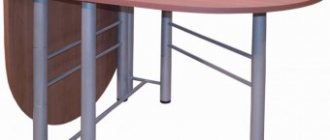What is railing?
A kitchen rail is a metal strip or pipe that is used to store kitchen utensils and food. Depending on the type of fastening, they can be of several types: • Horizontal – mounted on the wall between the upper, wall, and lower cabinets. Today, this is the most popular type, since thanks to this method, ladles, napkins, oven mitts and coasters for hot dishes are always at hand. • Vertical – connect the wall shelf to the table top, or to the floor. They are a little less common, as they take up a little more space, because they do not have hooks, but only special shelves. • Suspended – usually attached to the ceiling. Such roof rails can often be found in various culinary programs. They are used primarily for storing pots, saucepans and frying pans, but they can also be used to store decorative items, such as wicker baskets or bunches of garlic.
Horizontal rails can be: Multi-tiered - short rails that hang one under the other are convenient if you do not have upper wall cabinets. Single-tier - one long pipe that is attached along the entire working surface, the most common form of railing system. Takes up minimal space.
In the photo there are shelves for railing in the kitchen
Types of roof rails
Manufacturers of furniture fittings produce several types of railing systems, differing in purpose and visual characteristics:
- Horizontal - the most common designs in which the tubes are located horizontally on the tabletop. They can be placed in one or several sections, hanging accessories on special hooks. One type of horizontal system is corner rails, which are usually suspended above the sink.
- Vertical – designed for installing shelves for glasses or fruit. One part of the pipe is mounted directly on the countertop, and the other is attached to the ceiling.
- Hanging – fixed to the ceiling and used for storing cutlery (glasses, cups, pans). This solution is usually preferred by the owners of large spaces with a bar counter or an island-shaped area.
What are the roof rails made of and what colors do they come in?
This wonderful kitchen accessory is made mainly of steel and has 4 main colors: • steel • copper • gold • bronze. The most common, of course, is ordinary steel (can be matte or chrome-plated), as it looks most harmonious in a modern kitchen. If you have a stylized kitchen, for example, in Provencal or English style, then the color “bronze” will fit perfectly into such a kitchen.
Gold or copper will be an excellent addition to a kitchen made of solid wood and having gold or bronze embossing on the facades.
If a simply made of steel and painted roof rail does not suit you, and your kitchen is designed in the now fashionable high-tech style, you can order an unusual roof rail with lighting, but it will cost much more than usual. For example, if 120 centimeters of a simple pipe costs from 150 to 300 rubles, then the price of a backlit roof rail starts from 1,000 rubles, and the price for a set (backlit roof rail and touch switch) will already be 10,000 rubles. Some manufacturers offer wooden roof rails. But they have more of a decorative function than a practical one. After all, wood cannot withstand frequent exposure to water and temperature changes. In the kitchen, such a roof rail will very quickly lose its attractive appearance (it will darken, dry out and crack).
What can be stored on the roof rails?
The main advantage of this method of storing things is that everything you need is always at hand, but does not occupy the working surface of the table. There are a huge number of related products for roof rails. These include hooks, shelves, and various glasses and coasters. Everything is clear with hooks: skimmers, towels, cutting boards, pastry brushes, etc. are hung on them. But with the choice of shelves it turns out to be more and more difficult, since you have to decide what exactly from the whole variety to buy, and which shelves will suit your kitchen. Rectangular shelves, square, corner radius... Each of them is functional in its own way, but you should know when to stop and not overload the railing with unnecessary details. It is best to limit yourself to one or two shelves, ten hooks and a metal stand for pots and pans.
Pictured is a kitchen rail
What and why is it needed?
What do we use most in the kitchen? •Detergents. •Poven mitts. •Salt and spices. •Cutting boards. • Ladles, spatulas. This is what the list of things that should always be at hand looks like. Therefore, it makes sense to place towels on hooks, and detergents on a hanging shelf next to the sink, spatulas for cooking and special hanging containers for spices can be placed near the stove. Cutting boards can be stored on hooks, but you can also purchase a special shelf for them. A special metal hot stand will make life and cooking much easier. Thanks to it, your countertop will always be safe (often the film that covers the countertops cannot withstand the temperature of the dishes removed from the stove) and storing such a stand is also very convenient: it has special handles and clings directly to the railing.
What types of shelves are there for kitchen railings?
When choosing shelves, you should consider what you will store on them. Most suppliers offer a separate shelf for each specific item. So, you can order a holder for foil, a holder for paper towels, jars for spices, the lids of which are already hooks for attaching to the railing. Thus, the simplest rectangular or radius shelves can be useful for placing detergents or some decorative elements on them, for example, a small flower in a pot or a beautiful candlestick. If you have a vertical rail with a hanging shelf, then you can buy a shelf-holder for glasses (glass holder), a round shelf on which you can store fruits or bread.
Installing a roof rail in the kitchen
If you order a new kitchen set, then there will be absolutely no problems installing the railing. The master who will install your furniture will also install the railing system. However, if you buy it yourself and want to install such a system yourself, then there should be no problems either. All you need is: 1.Building level. 2. Drill. 3. Hex key. Using a level, we make markings for the fastening.
The railing should be mounted at chest level, then it will be convenient for you to remove and hang up everything you need.
After the markings have been made, use a drill to drill holes for the dowels, then insert a self-tapping screw into the sleeve and screw it into the hole with the dowel. All supports for the railing system are secured in the same way. But you should remember that if you install a long railing, then the number of supports per 1 meter of railing should be at least 3 pieces. As can be seen from the article, the railing system for storing dishes and food in the kitchen is not only convenient, stylish and relevant, but also very easy to install and use. Modern stores are ready to offer housewives a huge number of design options for such a system: horizontal (single- and two-tier), vertical, with mounting to the ceiling. The variety of colors is also impressive: stainless steel, chrome-plated, stylized gold, or copper. And convenient and stylish accessories that perfectly complement this system will not only give your kitchen a unique charm, but will also save time and free up space.
Choosing a location and installing a roof rail
The location for installing the railing is selected based on the location of the kitchen furniture, the functional purpose of the individual elements and ease of use. The length of the supporting steel tube of the railing, regardless of the shape and options for its location, is limited only by the size of the room, the required free space and, of course, aesthetic preferences.
Railing design for the kitchen.
The standard length of the railing is 3 m, but if necessary, it can be shortened or extended using special couplings and inserts. The ends of the pipe are closed with decorative plugs to ensure safety of use and give the structure a finished look.
After the initial preliminary marking of the location, determining the length, number and shape of the rails, we install supporting structures, which will be the basis for attaching the pipes to the load-bearing wall, ceiling or furniture walls in the kitchen.
It should be taken into account that the installation step of the railing fastening elements should not exceed 0.5 m, that is, if a pipe 1 meter long is installed, then the number of points for attaching it to the load-bearing surface should be at least 3, 2 at the edges and 1 in the middle parts.
Markings for installing horizontal or vertical railing should be done using a building level or plumb line at the height required for hanging objects. When marking, you should take into account the size and weight of kitchen utensils hung on the railing and, accordingly, additional holders. If you plan to use the railing for massive objects, then the fastening step should be reduced.
Choice of roof rail color
Manufacturers offer us a large selection of colors: old gold, brass, bronze, copper. But the most popular colors are nickel, chrome and anodized aluminum. When choosing a color, professionals advise basing your choice on the design of your kitchen appliances.
Accessories for railing
There is a huge amount of additional accessories for the railing system. The main one is an S-shaped hook, on which kitchen tools cling. Moreover, with the correct placement of the railing, sometimes there is no need for upper cabinets.
Within walking distance of you, there is a service for calculating cabinet furniture.
How to install a kitchen rail
Every woman dreams of having a railing system in the kitchen. Therefore, you will make a good gift by installing this accessory for her yourself. Moreover, there will not be any special difficulties. You will need a hammer drill, a level, a hacksaw and a Phillips screwdriver.
The kit includes a main chrome bushing that holds the rack. A sleeve with a groove that is attached to the wall with a self-tapping screw and then the main one is mounted on it. Two black mounting bolts, a self-tapping screw, a hexagon and a dowel.
Insert the self-tapping screw into the mounting sleeve. I recommend immediately replacing the dowel with a more reliable one so that there are no problems in the future. We tighten the black mounting bolts into the main chrome bushing. Where one bolt will hold the bushing, and the second the rail.
What is a railing system
Few modern kitchens can manage without a railing system these days. An ordinary hollow tube with hooks located on it turned out to be an indispensable assistant for housewives, and is often a decoration and attracts the attention of guests.
Railings as a system for organizing the storage of kitchen utensils have entered our homes from cafes and dining rooms. There they carried a functional load: the cooks had no time to search and select the necessary pots, stewpans or knives on numerous shelves and cabinets. Therefore, placing kitchen tools in plain sight made their task much easier. Now all those who like to work magic in the kitchen can appreciate all the advantages of roof rails.
Installing roof rails has long been no longer a sign of luxury. The basis of the railing is a hollow tube or rod with a diameter of several centimeters, most often made of stainless steel. It is attached to the wall using holders, most often sold as a set. After attaching the tube, hooks, shelves and other elements, now available in a wide variety, are hung on it. Depending on the size and type of structure, almost everything can be located on the railing - from a pepper shaker to a lid or even a frying pan.
Installing a roof rail in the kitchen: where, how and why it is installed
The kitchen work area, first of all, should be functional and rational - everything should be at hand, otherwise working will be inconvenient and tiring. To achieve such functionality, a person resorts to the help of various things and devices, without the use of which it is even difficult to imagine a modern kitchen. One of these devices is a railing - this is a thin tube mounted on the wall, which allows you to place all the most necessary utilities on it using small devices. It is about this device, or rather about how the roof rails are installed in the kitchen, that we will talk about on this page of the okuhne.net website.
Installing a roof rail in the kitchen photo
Varieties
There are a few . The choice of suitable crossbars depends on their appearance, car model, type of fastening, dimensions and materials of which the crossbars are made.
By material
Rails are divided into metal and metal-plastic. The first type of manufacturing materials used are steel or aluminum. The second type is made of hard plastic; the load capacity of such roof rails is an order of magnitude lower than metal ones.
By installation method
Car roof rails can be longitudinal or transverse. The first type crosses the roof, and the other is placed in the direction of movement of the car. In rare cases, you can find a model of combined roof rails that combine these two types.
By design
Universal roof rails can be installed on the roof of any car, while model crossbars can be installed on the roof of a specific car brand.
You can also find support and integrated rails on sale. Parts belonging to the first type are mounted on supports, and there is a gap between them and the roof. Integrated ones fit tightly to the roof of the car.
According to the length and diameter of the arc
The choice of parts for the diameter of the arc and length depends on the type of trunk used on the car. Depending on the dimensions of the car roof and the size of the trunk used, two or three support rails or integrated cross members with a large arc diameter are used. The larger the dimensions and load capacity of the trunk, the more supports are used to securely secure the roof rails to the roof of the car.
By color and shape
The shape of almost all models of roof rails is the same - the parts are made in the form of rods slightly bent into an elongated arc. There are significant differences in color design: parts made of black steel are sold on the market, which matches the color of almost any car; silver and black matte roof rails are also in demand among drivers.
Installing roof railing in the kitchen: its capabilities and types
Before deciding how to install a roof rail in the kitchen, you should solve another question: where to install it? And the answer to this question can be obtained by studying the capabilities of this device and its varieties. There aren’t that many of both, so let’s look at them point by point – let’s start with the capabilities, or rather, with the additional devices that provide these same capabilities. As a rule, the roof rail can be equipped with the following additions.
- Hooks. Quite a lot of them fit on the tube, and they fully allow you to hang quite a lot of stuff on the wall. We will not be specific, since the railing with hooks can be used not only for placing ladles and spatulas, but also for many other things - towels, bags, cutting boards, etc.
- Shelves. As a rule, these are small horizontal lattice platforms that are attached to the railing using hooks - the shelves hang on it and allow you to store all the little things necessary for cooking. Spices at hand are convenient and practical, but, as a rule, the matter is not limited to them. Let me emphasize once again that you can keep anything on such open shelves - however, you should remember that not every kitchen utensil can serve as decoration.
How to hang a roof rail in the kitchen photo
And that's not all the railing devices. The products listed above belong to the category of universal ones - in addition to them, there are also highly specialized devices. For example, a holder for disposable towels, a device for bottles and jars, cutting boards and even stands on which it is convenient to hold your favorite magazine with your favorite culinary creation. You understand that such a variety of devices for railing allows you to install it not in any specific place, but almost everywhere. It is for this reason that modern kitchens are equipped with long rails extending from edge to edge of the worktop with all its twists. In fact, it allows you to use the kitchen apron to its fullest potential and for practical purposes, and not just as decoration. As for the varieties of this product, there are only two of them - single railing and double. In the latter case, this product can be represented in the form of two parallel tubes located above each other and offset with respect to the wall. You understand that the functionality of this railing can be much greater.
How to attach a rail to a wall
Installing a roof rail in the kitchen for a DIYer will not be difficult and will not take much time. For successful work and high-quality results, you must have:
- electric drill;
- screwdriver (can be replaced with a drill);
- hammer;
- hex wrench;
- laser level (you can use a regular construction level);
- railing system kit;
- self-tapping screws with plastic dowels.
The first step is to decide on which wall the structure should be mounted. As a rule, a place is chosen for this above the countertop, not far from the sink or stove.
To install railings, many people use the side walls or bottom shelves of wall cabinets. It also saves space in the kitchen.
Typically, the tubes are placed at chest or eye level, and at a distance of 5-8 centimeters from the bottom of the cabinets. But only the hostess can determine the convenience of the location, based on her needs. Therefore, it makes no sense to discuss what the height of the structure should be above the countertop or floor.
The roof rails should be attached in several stages, no matter how much you would like to do it faster and easier. The structure must be strong and reliable so that it is impossible to pull it out with little effort.
- Mark holes at the selected location and then drill them.
- Install bushings.
- Secure the supports.
- Mount the roof rails.
Marking and preparation
The railing on the wall must be positioned strictly horizontally, otherwise the necessary accessories will not be supported on it. Hooks and shelves will simply slide down the inclined plane. You should not measure the distance from the floor or ceiling to the holes. To determine the required “horizon” there is a regular construction or laser level.
Short rails up to one meter in size should be attached at two points, and long ones at three or even four places. In accordance with these requirements, holes are marked.
Using an electric drill, drill holes with a diameter corresponding to the fasteners. The drill must be selected depending on the material of the walls and cladding. For example, for concrete and ceramic tiles, drills with a diamond coating or a pobedit tip are intended.
Installation of bushings
The dust formed during the work process is blown out of the drilled holes and plastic dowels are driven into them by lightly tapping with a hammer. They must fit inside with little effort, otherwise the railing can be accidentally pulled out during operation.
A self-tapping screw is inserted into the sleeve, after which it is screwed with a screwdriver into the dowel already in the wall. This way the bushing will be firmly and securely fixed.
Attaching the supports
The supports for the railing are rectangular or cylindrical parts with two holes. One of them is intended for the bushing, and the other, larger in size, is for the tube.
The support is placed on the bushing installed in the wall and securely attached to it with small screws using a hex key.
The final stage
The railing is inserted into the prepared supports and secured with screws in the desired position. In this case, the tube is placed in such a way that its ends on both sides evenly protrude beyond the supporting elements.
If it is necessary to increase the length of the structure, two adjacent elements are connected using an internal plastic coupling. To ensure the reliability of the joint, additional support is installed in its place.
At the end of the work, carefully hammer the plugs into the ends of the railing with a rubber or wooden hammer to avoid damage to the nickel or chrome plated surface.
Traditionally, roof railing systems are made of chrome-plated or nickel-plated steel. But manufacturers try to take into account the wishes of consumers, so they produce roof rails in several colors and modifications.
In modern kitchens, it is appropriate to install shiny silver rails, and for a classic interior with a wooden kitchen set, pipes in gold, copper or bronze shades are more suitable.
Above the island part, railing structures are attached to the ceiling directly above the work table. All the necessary kitchen utensils are hung on them, including teapots and pots, as well as bunches of onions or garlic. The housewife will need to reach the nearest wall, so a suspended structure will come in handy here.
When choosing kitchen accessories, experts recommend not to chase the latest fashions and not to listen to the advice of your neighbors. In this matter, you should rely solely on your preferences and tastes. Only then will the kitchen become cozy and comfortable.
A car is not only a means of transportation, but also an assistant in everyday life. It is perfect for transporting goods over a variety of distances. This could be building materials, personal belongings, sports equipment, and so on. But the standard trunk has limited volume, so transporting a number of items may cause problems.
One way to solve the problem is to attach the trailer to the towbar and load everything you need into it. But there are several disadvantages here:
- the trailer will have to be registered, which entails financial costs;
- Riding with such a “locomotive” is not the most pleasant experience. Especially if things are transported over long distances.
There is a simpler solution. Car roof rails will help you transport a bicycle, boat, large construction materials or other luggage. With such a product it is easy to secure even the most bulky and oversized loads.
Attaching the railing in the kitchen: how it works
First, let's look at the design of this device - this way, at least, it will be easier to understand how it is installed. The railing consists of two main parts.
- The supporting tube, which, in turn, also has two constituent elements - the tube itself and two plugs that not only close the voids of the pipe, but also serve as a kind of limiter that does not allow hooks and other devices to move and thereby fall off the tube . The plug also consists of several parts - it is a plastic plug that is driven inside the tube and serves as a kind of chop for screwing in a self-tapping screw, which, in turn, is rigidly connected to the decorative cap.
How does a kitchen rail work? photo
Despite such a relatively large number of small parts of the railing, installing this device is quite simple - if you exaggerate, you only need to drill a couple of holes in the wall and secure the railing itself in them using self-tapping screws.
Install bushings and fasten supports
The holes are drilled. Next, you need to remove dust from them and prepare dowels and screws.
- Take a plastic dowel and a small hammer. Drive the dowel into the hole by tapping lightly with a hammer. The latter must enter the hole with force so that the pipe does not accidentally fall during operation;
- Now insert the self-tapping screw into the bushing;
- Take a screwdriver and screw the self-tapping screw into the dowel that is already fixed in the wall. This will secure the bushing firmly and firmly.
Everything is ready for the final installation of the railing. Now you need to secure the supports, since installing roof rails in the kitchen without them is simply not possible. What is a support? This is a rectangular or cylindrical part that has two holes.
It is included in the railing system kit. A small device will have two supports, a long one will have three, and a multi-tier system will have several supports for each pipe.
- The support is equipped with two holes - one for the bushing, and the second for the metal tube. One hole will be larger - it is intended for a pipe;
- The support must be placed on the sleeve (you have already installed it in the wall) and secured with screws using a hex key. Screws are included with the roof rail system.
Now you need to insert the rail itself into the prepared supports and secure it with screws. An important point is that the pipe should be fixed so that the ends protrude evenly beyond the support on both sides.
You have completed the main and main stage of installation and now you know how to attach the railing in the kitchen. All that remains is to take the plugs and carefully hammer them into the ends of the railing pipe. Next you can place kitchen items and accessories.
If you need to increase the length of the system, you can connect the two railing pipes using a special plastic coupling. To ensure that the system is securely fixed, you can install an additional support at the junction of two pipes.
How to hang a roof rail in the kitchen: installation guide
To make it easier to understand how to install a roof rail in a kitchen, let’s present the entire installation process in the form of a short instruction. For those who like visual aids, we have attached a video on how to install roof rails in the kitchen.
- We mark the location of the fasteners and the railing itself. Everything here is quite simple - take a tape measure and make a mark with a pencil or marker at a distance of 50mm from the bottom of the upper cabinets. This is the height of the railing in the kitchen. Next, using a level, we draw a horizontal line relative to this mark, which will determine the location of the railing at the horizon level.
- Mark the locations for drilling holes. Everything here is quite conventional, but for the railing to look beautiful, its fastening elements must be located at an equal distance from the edges of the tube. You can even go the simple route - assemble the railing completely, attach it to the wall and mark several points on a horizontal line, which will indicate where to drill the holes.
- We drill holes. To prevent the tile from bursting from the impact of a drill or hammer drill, it is better to disable this function of the tool - then it can be turned on again, but it is advisable to do this only after the tile itself has been drilled.
- Install the mounting bushings. To do this, we first drive plastic plugs (chops) into the previously drilled holes. Then, having installed the self-tapping screw included in the kit inside the bushing, we simply screw it to the wall with a screwdriver - this is what we do with all the installation bushings. By the way, there can be more than two of them - if the length of the railing exceeds 1.5 m, then the device is equipped with three fasteners. There is no need to be scared; the essence of installing the railing does not change.
- We put the second halves of the fasteners on the tube - make sure that the clamps are located at the bottom of the tube. This way they will not be visible after installation.
- Now we put the fasteners on the bushings and connect them to each other with screw fasteners. To do this, you will need a small hex key, which is usually included with the roof rail.
- Now the final stage - you need to install the plugs. They can be different, but in most cases their installation is carried out by simply hammering plugs into the tube. It should be understood that a hammer can damage the chrome coating of the plug - you need to place a wooden plank on it and only then hammer it in. Alternatively, the process of installing the plugs can be done with a wooden hammer handle.
Fastening the roof rails in the kitchen photo
In principle, that’s all, all that remains is to hang up all sorts of hooks and shelves, but you can deal with this issue without me.
As you can see, installing roof rails in the kitchen is not a difficult task and is quite acceptable for doing it yourself. The only thing that remains to be added is that you don’t have to think too much about the question of what and where to hang - as they say, life itself will dot the i’s and indicate the place of each individual kitchen utensil. In general, you will have to rehang the hooks and shelves quite often during the first time you use the railing - but this is a simple process that can be done without tools.
Drilling holes for installing roof rails
As a rule, kitchen walls are finished with tiles, which are laid on a concrete base. In this regard, drilling holes for the railing holders must be done with a special drill with a Pobedit tip or diamond coating using an electric drill or hammer drill.
Railing mounting diagram.
After the final marking of the mounting points for the railing supports, “crosses” with a side length of 5-6 mm are applied on the surface of the tile at the drilling points using a diamond glass cutter. In this case, when drilling, the tile will not crack, the hole will be located at the required point.
To install a railing of small thickness with a relatively low mechanical load on it, you can use a drill with a diameter of 5 mm to drill holes. If it is necessary to provide large loads, it is necessary to use drills with a diameter of 8 mm or more. The depth of the holes is determined by the length of the mounting screws and the length of the plastic inserts into which the mounting screws will be screwed.
After the holes for attaching the railing posts are drilled, standard plastic plugs are inserted into them, the length of which corresponds to the length of the mounting screws. With their help it is necessary to secure the supports. Using self-tapping screws, intermediate fastening pins are secured to the ceiling, room walls or furniture walls according to the markings (for fastening load-bearing racks).
Care must be taken to ensure that the screws are tightened all the way and that the supporting pins are installed without any backlash or distortion.
The railing posts are placed on the supporting pins and secured to them using shaped screws. When installing, make sure that the screw heads are not visible. For example, on a horizontal rail they should be located at the bottom of the post, and on a vertical rail they should be located either on the top or bottom side of the posts (depending on the height of the mounting points).











